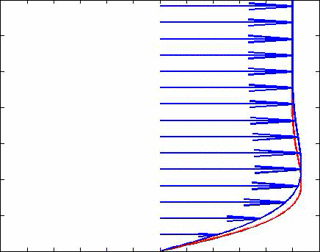I assume you are referring to what happens when such a plane wave is propagating parallel to a solid surface. You are correct that strictly speaking, the acoustic particle velocity, like the mean flow velocity, must obey the no-slip condition at the wall. Viscous effects become important very close to the wall only, such that the acoustic motions are no longer sufficiently described by the classical wave equation, as they are far away from the wall.
Consider a plane wave of the type you specified traveling adjacent to a wall. The linearized momentum and energy equations may be written like so:
$$ \bar{\rho}\frac{\partial u'}{\partial t} + \frac{\partial p'}{\partial x} = \mu\frac{\partial^2 u'}{\partial y^2} $$
$$ \bar{\rho}c_p\frac{\partial T'}{\partial t} - \frac{\partial p'}{\partial t} = k\frac{\partial^2 T'}{\partial y^2} $$
Recall that in normal boundary layer theory we neglect the pressure gradient normal to the wall on the hypothesis that the boundary layer is thin. So, although the velocity changes considerably throughout the region, the pressure remains approximately at its free-stream value throughout. This is one of the crucial assumptions of boundary layer theory generally, and we have written the acoustic boundary layer equations above under the same assumption.
Following the pressure argument, we may replace the $ \partial p'/\partial x $ term with the rate of change of the acoustic momentum due to the wave in the free stream. Likewise, we may set the acoustic pressure to that of the free stream wave in the energy equation:
$$ \bar{\rho}\frac{\partial u'}{\partial t} - \bar{\rho}\frac{\partial u'_\infty}{\partial t} = \mu\frac{\partial^2 u'}{\partial y^2} $$
$$ \bar{\rho}c_p\frac{\partial T'}{\partial t} - \frac{\partial p'_\infty}{\partial t} = k\frac{\partial^2 T'}{\partial y^2} $$
Now, assuming all quantities vary harmonically as $ e^{i\omega t} $, we may develop analytical solutions for the acoustic particle velocity and temperature within the boundary layer:
$$ u(y) = u_\infty [1 - e^{-(1+i)y/\delta_u}]e^{i\omega t} $$
$$ T(y) = T_\infty [1 - e^{-(1+i)y/\delta_T}]e^{i\omega t} $$
where $ \delta_u =\sqrt{2\mu/\bar{\rho}\omega} $ and $ \delta_T = \delta_u/\sqrt{Pr} $ are respectively, the boundary layer thicknesses of the velocity and temperature fields. An animation for a free stream wave frequency of 30 Hz and Pr = 1.5 is shown below to better understand these solutions. So indeed, very close to the wall we see lag effects on the velocity which causes it to be out of phase with the velocity (and hence pressure) in the free stream. The velocity vectors are in blue, and the temperature is in red.
If this was not exactly what your question was referring to, I apologize for misinterpreting.


